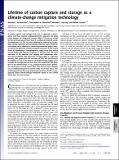The lifetime of carbon capture and storage as a climate-change mitigation technology
Author(s)
MacMinn, Christopher W.; Herzog, Howard J.; Juanes, Ruben; Szulczewski, Michael L.
DownloadJuanes_Lifetime of carbon.pdf (1.937Mb)
PUBLISHER_POLICY
Publisher Policy
Article is made available in accordance with the publisher's policy and may be subject to US copyright law. Please refer to the publisher's site for terms of use.
Terms of use
Metadata
Show full item recordAbstract
In carbon capture and storage (CCS), CO[subscript 2] is captured at power plants and then injected underground into reservoirs like deep saline aquifers for long-term storage. While CCS may be critical for the continued use of fossil fuels in a carbon-constrained world, the deployment of CCS has been hindered by uncertainty in geologic storage capacities and sustainable injection rates, which has contributed to the absence of concerted government policy. Here, we clarify the potential of CCS to mitigate emissions in the United States by developing a storage-capacity supply curve that, unlike current large-scale capacity estimates, is derived from the fluid mechanics of CO[subscript 2] injection and trapping and incorporates injection-rate constraints. We show that storage supply is a dynamic quantity that grows with the duration of CCS, and we interpret the lifetime of CCS as the time for which the storage supply curve exceeds the storage demand curve from CO[subscript 2] production. We show that in the United States, if CO[subscript 2] production from power generation continues to rise at recent rates, then CCS can store enough CO[subscript 2] to stabilize emissions at current levels for at least 100 y. This result suggests that the large-scale implementation of CCS is a geologically viable climate-change mitigation option in the United States over the next century.
Date issued
2012-04Department
Massachusetts Institute of Technology. Center for Computational Engineering; Massachusetts Institute of Technology. Department of Civil and Environmental Engineering; Massachusetts Institute of Technology. Department of Mechanical Engineering; MIT Energy InitiativeJournal
Proceedings of the National Academy of Sciences of the United States of America
Publisher
National Academy of Sciences (U.S.)
Citation
Szulczewski, M. L. et al. “From the Cover: Lifetime of Carbon Capture and Storage as a Climate-change Mitigation Technology.” Proceedings of the National Academy of Sciences 109.14 (2012): 5185–5189.
Version: Final published version
ISSN
0027-8424
1091-6490